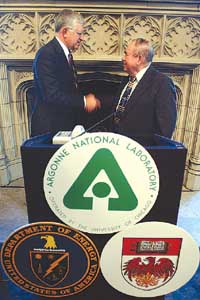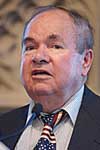Nobel in Physics goes to Argonne scientist
By Steve KoppesNews Office
 President Randel congratulates Alexei Abrikosov, Distinguished Scientist at Argonne National Laboratory, who shares the 2003 Nobel Prize in Physics. The University, which operates Argonne for the U.S. Department of Energy, hosted his press conference Tuesday. |
At a Tuesday, Oct. 7 press conference where Abrikosov greeted local media about his prize, Thomas Rosenbaum, Vice President for Research and for Argonne National Laboratory and the James Franck Professor in Physics and the College, said, “Alex Abrikosov is emblematic of the University’s and Argonne’s efforts to attract the absolute best people to our joint research environment. Alex’s insights and discoveries have launched 50 years of studies into the fundamental nature of superconductivity.”
Kathryn Levin, Professor in Physics and the College, said of Abrikosov: “He’s one of my heroes. He’s done some wonderful work.”
Superconductors are known both for their ability to carry current without resistance, and for expelling magnetism, the latter being the basis for applications like magnetically levitating trains. Abrikosov showed that under certain circumstances, some of the magnetism manages to find its way back into the superconductors via bubbles so small that they contain a tiny number of atoms.
 Alexei Abrikosov, Distinguished Scientist at Argonne National Laboratory. |
Abrikosov showed that when the magnetic bubbles enter the superconducting material, they form a lattice, in much the same way that atoms do in the crystal framework of a solid, said Rosenbaum.
“Once these vortices are in the superconductor, if they move, then it’s no longer useful,” Rosenbaum said.
The University has managed Argonne National Laboratory for the U.S. Government since the laboratory was founded in 1946.
![[Chronicle]](/images/sidebar_header_oct06.gif)